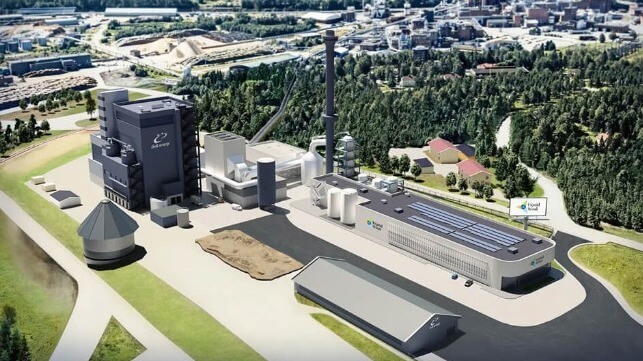This New Methane Conversion Innovation Could Be Huge for Shale
The U.S. Department of Energy’s (DOE) Brookhaven National Laboratory and scientists at several collaborating institutions have engineered a highly selective catalyst that can convert methane into methanol in a single, one-step reaction at a temperature lower than required to make tea. This discovery marks a big step forward over more complex traditional conversions that typically require three separate reactions, running at vastly higher temperatures. On an industrial scale, the simplicity of the system could mark a breakthrough in tapping “stranded” natural gas reserves in isolated rural areas, far from chemical refineries and other costly infrastructure, says Brookhaven chemist and study co-author Sanjaya Senanayake. Such local deployments would remove the need to transport high-pressure, flammable liquified natural gas. According to the scientists, such local deployments would remove the need to transport high-pressure, flammable liquified natural gas. Methane is a major component of natural gas and a potent greenhouse gas while methanol is used as an alternative biofuel for internal combustion and other engines. "We could scale up this technology and deploy it locally to produce methanol that can be used for fuel, electricity, and chemical production," Senanayake said.
Brookhaven Science Associates, which manages Brookhaven Lab on behalf of DOE, and the University of Udine have filed a patent cooperation treaty application on the use of the catalyst for one-step methane conversion and are exploring ways to work with entrepreneurial partners to bring the technology to market. This discovery builds on results from previous studies with the new recipe for the catalyst containing an additional ingredient: a thin layer of "interfacial" carbon between the metal and oxide.
"Carbon is often overlooked as a catalyst. But in this study, we did a host of experiments and theoretical work that revealed that a fine layer of carbon between palladium and cerium oxide really drove the chemistry. It was pretty much the secret sauce. It helps the active metal, palladium, convert methane to methanol," said chemical engineer Juan Jimenez, a Goldhaber postdoctoral fellow in Brookhaven Lab's Chemistry Division and the lead author of the paper published in the Journal of the American Chemical Society.
Also known as wood alcohol, methanol (CH3OH) is considered an alternative fuel under the Energy Policy Act of 1992 with chemical and physical fuel properties similar to ethanol. Methanol was used in the 1990s as an alternative fuel for compatible vehicles; however, current research mainly focuses on its potential use as a sustainable marine fuel.
Lowering Methane Emissions
It’s too early to determine the scalability and economic viability of the one-step catalytic conversion technology. However, if successful, it could prove useful in helping the U.S. shale patch clean up its act by cutting methane emissions.
The U.S. Oil & Gas sector is producing 8x above the volume of methane many operators have pledged to achieve by 2030 to reach their climate goals, a fresh study by non-profit Environmental Defense Fund recently revealed. The environmental advocacy group conducted ~30 flights between June and October 2023, covering oil and gas basins that account for nearly three-quarters of onshore production. The data collected showed that, on average, around 1.6% of gross gas production is released as methane into the atmosphere, about eight times higher than pledged by producers under the Oil and Gas Climate Initiative and the Oil & Gas Decarbonization Charter.
Over the past couple of decades, methane concentrations in the atmosphere have increased sharply, from 1,700 parts per billion (ppb) in 1990 to 1,930 ppb currently. Although methane is much less plentiful in the atmosphere compared to CO2, it’s still able to do plenty of damage at even lower concentrations thanks to being more than 80x more powerful at warming the earth than CO2 over 20 years and 28x more powerful on a 100-year timescale. The fossil fuel sector has been a major contributor to the rapid buildup of methane in the atmosphere, with emissions from venting, leakage, and flaring in the oil and gas sector currently estimated to be responsible for ~25% of global anthropogenic methane emissions. A single gas leak can be quite devastating: Last year, environmental intelligence firm Kayrros SAS deployed National Oceanic and Atmospheric Administration's Geostationary Operational Environmental Satellites (GOES) to quantify a gas pipeline by the Williams Companies Inc. (NYSE:WMB) spewed about 840 metric tons of methane into the atmosphere after a farmer in Idaho accidentally ruptured it while using an excavator. Currently used for weather forecasts, scientists recently discovered that GOES is effective at detecting large methane emissions of around tens of metric tons an hour or larger.
Last year, the U.S. pipeline regulator unveiled new rules aimed at lowering methane leaks from the vast network of 2.7 million miles of natural gas pipelines in the country. The proposal could "significantly improve the detection and repair of leaks from gas pipelines... deploy pipeline workers across the country to keep more product in the pipe, and prevent dangerous accidents," the Transportation Department's Pipeline and Hazardous Materials Safety Administration said.
By Alex Kimani for Oilprice.com




